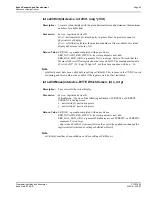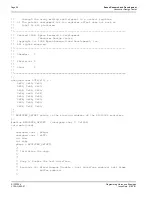
Epson Research and Development
Page 55
Vancouver Design Center
Programming Notes and Examples
S1D13504
Issue Date: 01/02/01
X19A-G-002-07
seGetId(Device, &ChipId);
if (ChipId != ID_S1D13504F00A)
{
printf("ERROR: Did not detect S1D13504.\n");
exit(1);
}
if (seSetInit(Device) != ERR_OK)
{
printf("ERROR: Could not initialize device.\n");
exit(1);
}
/***************************************************************************
* Fill 2M bytes of memory with 0xffffffff (white)
* Note that 0x200000 == 2 M bytes. Divide by 4 for number of Dwords to fill
***************************************************************************/
seWriteDisplayDwords(Device, 0, 0xffffffff, 0x200000/4);
exit(0);
}
9.1.2 Sample code without using 13504HAL API
/*
**===========================================================================
** INIT13504.C - sample code demonstrating the initialization of the S1D13504.
** Beta release 2.0 98-10-22
**
** The code in this example will perform initialization to the following
** specification:
**
** - 320 x 240 single 8-bit color passive panel.
** - 75 Hz frame rate.
** - 8 BPP (256 colors).
** - 33 MHz input clock.
** - 2 MB of 60 ns FPM memory.
**
** *** This is sample code only! ***
** This means:
** 1) Generic C is used. I assume that pointers can access the
** relevant memory addresses (this is not always the case).
** i.e. using the 13504B00B card on an Intel 16 bit platform will require
** changes to use a DOS extender to access memory and registers.
** 2) Register setup is done with discreet writes rather than being
** table driven. This allows for clearer commenting. A real program
** would probably store the register settings in an array and loop
















































